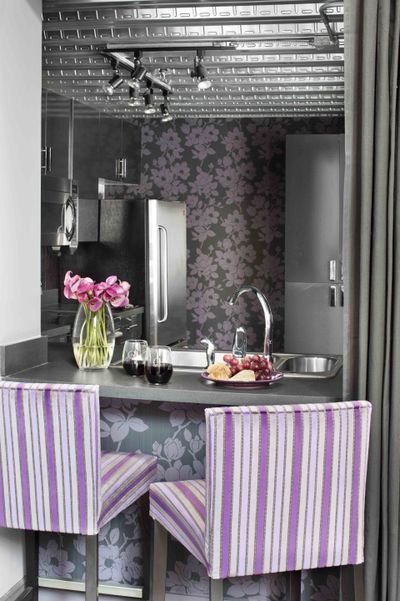Modernized florals play with scale, color in décor

After years of simple solids and geometric prints, the lowly flower is making a comeback in decor. Floral patterns have been blooming all over fashion runways in recent months, and they are slowly finding their way back into the world of home decorating, too.
Not long ago, any mention of floral prints conjured memories of 1980s cabbage roses, flowery shabby chic borders stenciled high on bedroom walls, and suburban homes designed to feel like precious cottages.
But today’s new patterns aren’t your grandmother’s florals. And they can be a refreshing antidote to the minimalist patterns that have dominated home decorating in recent years.
“It’s what we’re all craving,” says New York-based designer Jon Call, founder of Mr. Call Designs. “It’s romance, it’s a softness … and it feels fresh again because no one has defined it for our generation.”
While brands like Laura Ashley delineated the floral look of a generation ago, the new florals have no rules. Which makes them more fun – and more challenging – to use successfully.
Here, Call and two other interior designers – Betsy Burnham of Los Angeles’ Burnham Design and Brian Patrick Flynn, executive producer of HGTV.com’s Spring House series – offer advice on working with this fresh crop of floral patterns.
What size?
“Scale is the most important factor in modernizing the look and feel of florals,” says Flynn. He suggests avoiding flowers that are depicted at actual size. Instead, pick patterns where the flowers are bigger – between 50 and 200 percent larger than life-size.
Call’s a fan of using vintage prints in “the largest scale you can find” so the print’s eye-popping size contrasts with its traditional style.
Call and Burnham also think floral prints can look modern if they’re printed on a very small scale, especially if they’re used on smaller items like throw pillows.
Which pattern?
Find a floral print that really appeals to you personally, Burnham suggests. “Nothing corny, nothing ordinary,” she says. You want “something really special.”
You might try “chinoiseries that include figures and florals,” Burnham says, “or flora and fauna… That’s a way to do it if you’re kind of scared of just flowers.”
Another option is choosing a pattern that’s more “botanical” than flower-filled, which “rely more on stems and leaves,” Flynn suggests.
Call points out that designers like Vivienne Westwood have created digitized, pixilated floral prints that mix traditional and modern style.
Flynn encourages clients to mix floral patterns with other prints.
“Anytime I’m dealing with a home occupied by couples arguing over masculine and feminine styles, I’m likely to mix botanicals or florals with classic masculine prints such as gingham, check or plaid,” Flynn says.
Where to use it?
Floral patterns can work especially well on sleek, modern pieces of furniture, Burnham says. Rather than choosing a floral sofa that’s rounded and tufted, use floral upholstery on a simple sofa with straight, clean lines.
And rather than hanging floral draperies in a bedroom or choosing a floral bedspread, use solid colored fabrics in those locations and then upholster the headboard in a bold, oversize floral.
What colors?
A great pattern can look dated in the wrong color palette, says Flynn. “Florals with mustard yellow and burgundy palettes instantly feel old and stuffy. To make them fresh and fun, look for those with unexpected color palettes, such as black and violet or springy greens and punchy pinks.”
Burnham says floral patterns done in just two colors (or in two shades of the same color) can look more modern than florals that include several colors. And “if you go for something on a crisp white background,” she says, it “might read more current than something on a tea-dye that’s more muted.”
Call thinks just about any color can work, though he prefers to steer clear of pinks and purples. You have to “be careful with the sentimentality,” he says, or you’ll lose some of the modern edge.